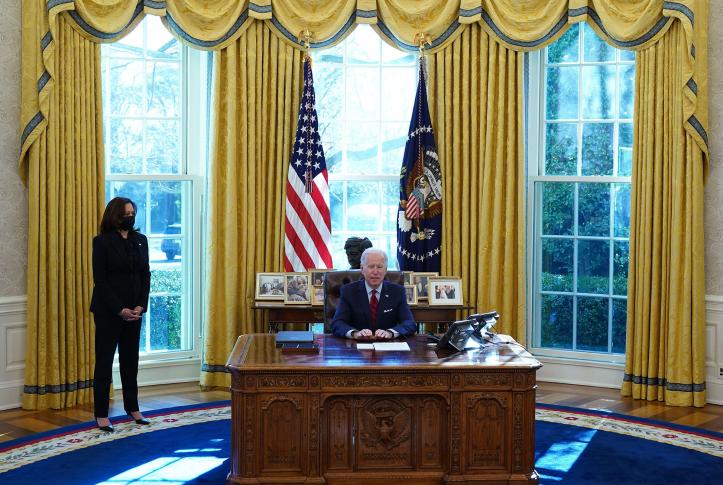The Biden administration got off to a strong start, issuing nearly 40 executive orders, memoranda, and presidential proclamations in its first 10 days.[1] Many addressed health issues. On Inauguration Day, the administration issued directives to block recent Trump regulations and remove roadblocks it had imposed to stall President Biden’s agenda; on January 21, it announced 10 COVID-19 directives; and on January 28, it announced an executive order to strengthen Medicaid and the Affordable Care Act’s (ACA) marketplaces, as well as a memorandum on women’s health.
Presidential Actions on Medicaid, the ACA, and Women’s Reproductive Health
The Medicaid and ACA executive order states that it is the policy of the Biden administration “to protect and strengthen Medicaid and the ACA and to make high-quality care accessible and affordable for every American.” The most immediate action directed the U.S. Department of Health and Human Services (HHS) to consider establishing a special-enrollment period (SEP) for the federal marketplace, which handles enrollment in 36 states. Several state-operated exchanges have announced they will follow suit. HHS announced that the enrollment period will run from February 15 through May 15 and will allow new enrollees to sign up and existing enrollees to update their enrollment information and change plans. CMS will spend $50 million on advertising and outreach. The enrollment period will occur during tax-filing season, allowing tax advisors and filing services to inform people and applicants to estimate their incomes more accurately for premium tax credit purposes.
Additionally, the secretaries of Treasury, Labor, HHS, and other departments are directed to review existing regulations, guidance, and policies to determine whether they are inconsistent with the goal of strengthening the ACA and Medicaid. They are directed to suspend, revise, or rescind – where applicable through notice and comment rulemaking – inconsistent agency actions. Heads of agencies are further encouraged to take actions to fully enforce the Biden policy. The areas for review are described in general terms, but include:
- Trump administration rules that allow states to abolish marketplace enrollment functions in favor of enrollment through private entities
- Medicaid 1115 waivers, such as work requirements or block grants, and ACA 1332 waivers that allow states to opt out of online marketplace enrollment
- Trump administration procedures and policies that made enrollment in Medicaid and ACA coverage more difficult, including some SEP enrollment verification procedures
- procedures and practices that reduce the affordability of coverage or financial assistance, including changes to the premium adjustment percentage and the “family glitch.”
The executive order also revokes President Trump’s Inauguration Day executive order calling for repealing and undermining the ACA and a later executive order calling for the expansion of short-term limited duration coverage, association health plans, and health reimbursement accounts. It directs federal agencies to suspend, rescind, or amend agency actions implementing these orders.
The women’s health memorandum directs HHS to consider revising, rescinding, or suspending Trump administration regulations governing the Title X family planning program, which prohibit Title X grantees from referring patients to abortion providers and impose onerous conditions on funding for grantees that provide abortions, which has driven many providers out of the program. The memorandum also revokes Trump administration policies that withheld foreign assistance from entities that perform abortions using non-U.S. funds or provided advice, counseling, or information regarding abortion, and encourages the funding of women’s health programs in other countries.
COVID-19 Presidential Actions
The administration issued executive orders, memoranda, and presidential proclamations related to COVID-19 to direct appropriate agencies to:
- establish a COVID-19 board to support testing efforts and address the cost of testing and strengthen the public health workforce
- rejoin the World Health Organization and support international efforts responding to COVID-19
- strengthen workforce safety protections
- provide guidance to schools and universities about safe reopening and assistance with online distance learning, and collect information on COVID-19’s impact on education, particularly the disparate impact on minorities
- require passengers to wear masks for domestic travel and be tested for COVID-19 for international travel
- establish a health equity task force and require agencies to ensure equitable treatment of minorities, underserved populations, and at-risk people in responding to the pandemic
- improve access to pandemic response supplies
- extend the availability of the National Guard for pandemic assistance
- ensure the collection and use of pandemic-related data for addressing public health threats
- expand affordability of and access to COVID-19 treatments and support the development of new treatments
- suspend entry into the United States of noncitizens from certain countries with high COVID-19 rates or variants
- require the federal workforce to observe COVID-19 safety measures and require compliance with safety measures in federal buildings and on lands.
Finally, an executive order was issued on Inauguration Day freezing administrative actions taken near the end of the Trump administration; another was announced to rescind or amend administrative regulations and guidance that make it more difficult for the Biden administration to reverse Trump policies and implement its own.
Implementing these policies will take months. The Biden administration has set an aggressive agenda to expand Medicaid and ACA coverage, make up for marketplace coverage losses that have occurred since 2016, restore access to women’s health services at home and abroad, and establish a plan for attacking the COVID-19 pandemic.




